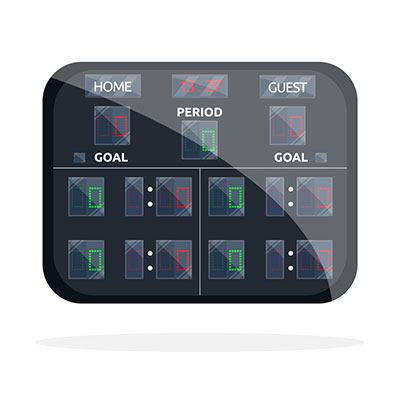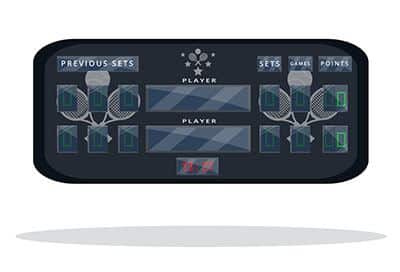If you want to know more about the lacrosse shot clock rules, you've come to the right place! In this post you will learn:
- what the shot clock is
- shot clock setup
- timekeeper duties
- breaks and restarts of the play
- quick and slow restart, and other regulations for the shot clock.
So, without any further delay, let's dive straight into the topic.
More...
Take away key points:
If you're not quite certain what the purpose of the lacrosse shot clock rules is, refer to the guide below for a better understanding. Let's start!
What is a game clock in lacrosse?
A game clock is used to regulate the length of the game, and ensure the play starts and ends on time. High school and college lacrosse use a neutral party or a volunteer to operate the clock.
What is a shot clock in lacrosse?

A shot clock is used in lacrosse to determine how much time the offensive team has left to shoot at the opponent's goal. The main purpose of the shot clock is to keep the lacrosse game fast and exciting and encourage the change of possession.
Without a shot clock, a team would get full possession of the ball, and might not try any scoring chances. In addition, the shot clock operators sit alongside the game clock operator at the scorer's table on the sideline.
What are the shot clock rules for the offensive team?
In men's lacrosse, the shot clock is eighty seconds, from the time the offensive team gains the ball possession, and the offensive team must take the possession to their offensive half of the field within the first twenty seconds.
Box lacrosse has a thirty-second shot clock, while women's lacrosse does not have a shot clock.
What are the timekeeper's duties?
The shot clock operator will start the shot clock once the offensive team gets the clear ball possession after a loose ball, live ball turnover, or a face-off. The shot clock timekeeper will stop the shot clock when the lacrosse official stops the game due to an injury, time out, or if a ball travels out of bounds.
Once he resets the shot clock, the clock is reset to the full eighty seconds, so the offensive team will have full possession for a valid shot on the goal. The timekeeper will restart the shot clock after each change of possession.
To signal the end of a period, the timekeeper will blow an air horn, and he will also be responsible for notifying players about releasable and non-releasable lacrosse penalties, and how much time they must spend inside the penalty box.
Quick & slow restart in lacrosse
There are two types of restraints in the game: quick restart and slow restart.
1. Quick restart
This is a restart in the play when the team granted the possession after a turnover or foul quickly resumes the play. A quick restart is called when there is a halt to the play on the offensive side.
If a penalty is called against defenders in the offensive zone, the attacking team must run or pass the ball outside the offensive area before they move on to the goal.
2. Slow restart
A slow restart in a play is why the shot clock is stopped, and the player is waiting for the official to blow the whistle and resume the game. The slow restart occurs after each period, after a team scores a goal, or after a time-out.
The referee checks if the field is set, and there is no player within five yards. Collegiate coaches prefer quick restarts as there is not enough time for the defense to prepare their strategies.
Special game clock rules
For injury timeouts or regular timeouts, the shot clock will continue for the remaining time if the offensive half of the field calls for a timeout. However, if the defensive team calls for a time-out, the timekeeper will restart the shot clock.
Such the NCAA men's lacrosse rules will give the advantage to the offensive half of the field, and discourage the defensive half of the field to call for timeouts simply to disrupt the offensive half of the field.
Recent changes to the shot clock made by the NCAA playing rules

Starting from the 2021-22 academic year, a collegiate-level team has a 60-second shot clock reset when the offensive team retains possession after taking a valid shot.
Furthermore, instead of the thirty seconds to get the ball into the restraining box, the NCAA men's lacrosse rules committee made new rules for the shot clock. Now, they will have twenty seconds to send the ball across the midline after they gain possession. The NCAA playing rules oversight panel approved the changes.
The clock shot will not restart during the flag-down, slow whistle scenarios. Once adjusted, the shot clock will reset to 60 seconds in the offensive half of the field, after loose-ball technical fouls. If a foul is committed and the clock is above sixty seconds, the shot clock will reset to eighty seconds.
Once play is stopped in slow whistle scenarios with the flag down, and the shot clock is at or below sixty seconds while the ball is in the offensive half of the field, the shot clock will reset to 60 seconds. When the shot clock is above sixty seconds, the shot clock will reset to eighty seconds.
FAQs
How does the game clock work in lacrosse?
The game clock starts and stops after each blow of the official's whistle, after the end of each period of the game.
Does the clock keep running in lacrosse?
Yes, the clock will keep running until the officials stop it. If a team leads by ten or more goals, the clock won't stop except for injuries, official, or team timeouts.
What is the 30-second clock in lacrosse?
When officials put on the shot clock as the team might not go for a goal or stall, the team gets thirty seconds for a shot.
Does the clock stop after a goal in lacrosse?
Yes, a clock will stop after each goal.
What is the 80-second clock in lacrosse?
This is a new NCAA men's rule in lacrosse, ensuring the team gets the new eighty seconds to shoot after shooting at the opponent's goal.
What is the 90-second shot clock for in lacrosse?
This is the rule when a team with possession has ninety seconds to shoot on the goal; otherwise, the opponents get possession.
What is the 20-second rule in lacrosse?
This is the rule requiring the team to clear the ball in twenty seconds when in possession of the ball. The official blows the whistle, signals failure to advance, and awards the ball to the opponent.
Conclusion
The game clock in lacrosse sets the time for the actions and ensures the game starts and ends on time. The shot clock is important because it keeps the players focused and motivated throughout the entire game.
It also allows fans to see how much time is left in the game so they can root for their team accordingly.
